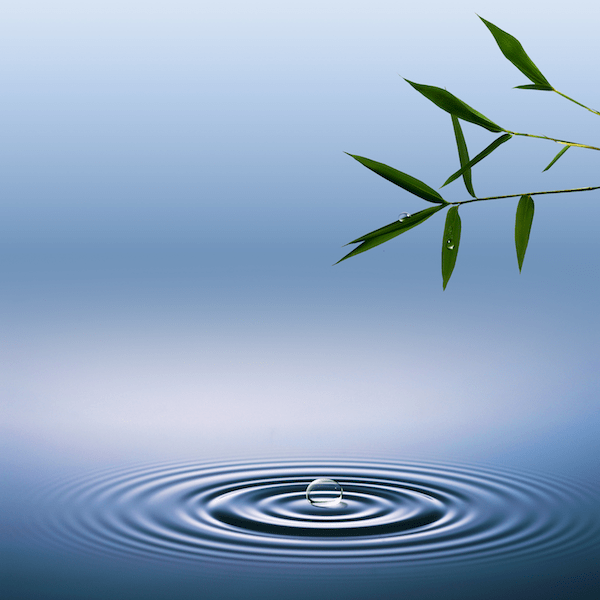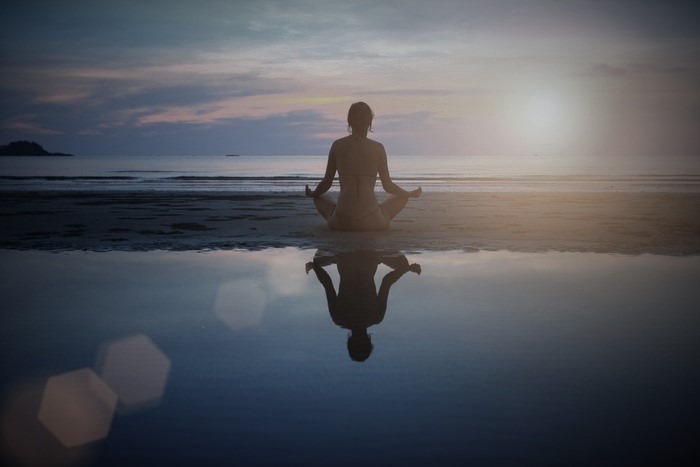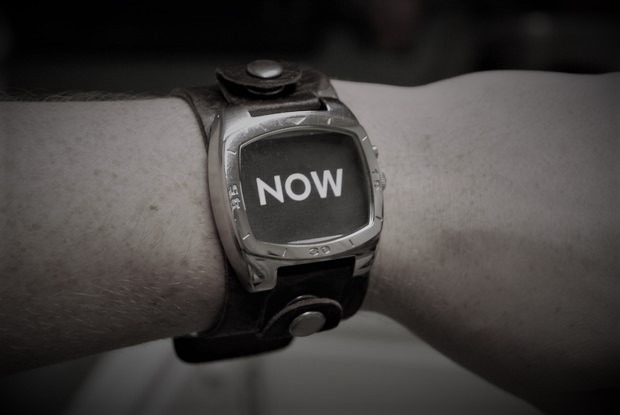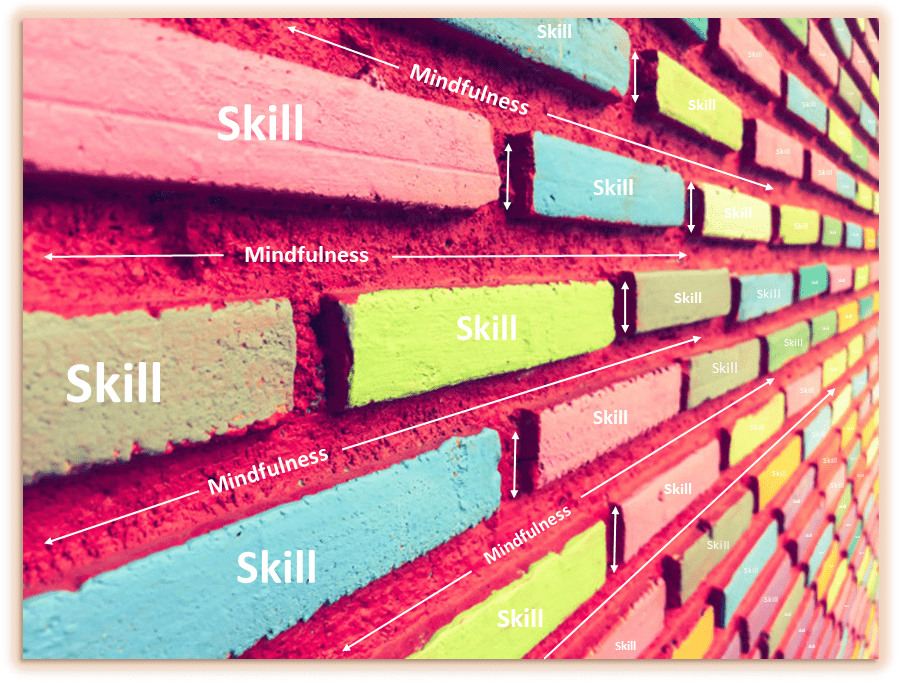What is Mindfulness ?

Overview
Although Mindfulness has gained popularity for its reputation to reduce stress, to decrease suffering, to increase resilience, and to enhance personal growth, there are also many misconceptions about what mindfulness is. Most importantly, mindfulness is NOT meditation. It is a way of paying attention that you can do while meditating, but you can also be mindfully aware with your eyes open – while engaging in meaningful activities (!)
Regular practice of mindfulness can lead to more self-awareness and less ‘reactivity’. Mindful awareness can improve your ability to self-regulate which gives you more choice over how you may respond when faced with difficult situations and/or difficult internal states (challenging thoughts, emotions, memories, sensations or imagery). However, as will be discussed, mindful awareness is not enough (other psychological, behavioural, and emotional skills are required).
This page aims to define and clarify mindfulness, to discuss how mindful awareness can help support you by opening up a world of choice over how you may respond to challenges, and to outline simple ways you can begin to be more mindful. The limitations of mindfulness are also outlined and additional skills that not addressed by mindfulness, are discussed.
The Purpose of Mindfulness
Aside from pleasant daydreaming, much of the remaining ‘passive’ mental states we experience can lead to negative thinking or distress. This is because most of our typical not-so-mindful states of mind vacillate between extremes. On the one hand, when we focus on memories we often become stuck on the ‘pains of the past’. This can lead to low mood states. On the other hand, when we think about the future, we can often get stuck in thinking about all that could go wrong (e.g. ‘what if ‘x’ happens…?’). This can lead to anxiety.
If the past and the future weren’t fraught enough, we can also get stuck engaging in rumination (‘overthinking’) about present problems, which can trigger negative mental ‘loops’ about undesirable aspects of ourselves (rumination that can trigger threat-based thinking, overthinking, or self-criticism).
In contrast, by engaging with our experience with mindful awareness, we are deliberately intending to cultivate a different kind of focus: We are aiming to notice and observe all experiences without judgment; we are aiming to be present to whatever is happening inside a given moment (as it ‘is’). This also extends to us being present to whatever is happening inside ourselves (i.e., as we ‘are’). For these reasons, mindful awareness is an active process which involves deliberate attention and the cultivation of curiosity.
As will be discussed, developing your ability to ‘stay present’ and to remain mindfully aware, will form a solid foundation for learning other helpful skills that you will likely need to learn and implement (depending on your unique situation).
In conjunction with therapy (and other skills), developing mindful awareness will allow you to:
- Improve your attention and increase your self-awareness,
- Allow you to observe your thoughts / feelings more objectively without over-identifying with them (or getting flooded and pushed around by them), and
- Reduce reactivity so that you have more choice over how you decide to respond to challenging thoughts / feelings / situations.
- Become more aware of what skills you might need to utilise in order to self-regulate, to break unworkable patterns, and to get your needs met.
With regular practice you will develop an ability to stay present and observe; you will likely experience a reduction in your reactivity and stress; and, you will begin to see things more clearly (i.e., without judgement or reactivity). In other words, you will be better able to see things for what they really are and this will free you up to be able to choose (vs react) how you want to respond to difficult (inner and external) situations.
Although simple-sounding, mindfulness is often very misunderstood. Moreover, for certain people, engaging in Mindfulness exercises may even have unintended negative consequences. So, before embarking on a journey to increase your mindfulness skill level, I recommend that you be discerning and deliberate about ‘how’ and ‘why’ you go about learning (and using) Mindfulness. As will be discussed, I often say that ‘Mindfulness is not enough’ (meaning that although mindful awareness is important and necessary, often skills tailored to your own unique situation are also required).
Mindfulness Defined
There are many definitions of Mindfulness. There is no standardized definition. This is because ‘mindfulness’ does not constitute a unitary construct, though it frequently includes aspects of paying attention moment-to-moment in a specific, concentrated and sustained, non-reactive way.
Firstly, Mindfulness is NOT meditation. This is important to remember: Mindfulness is a way of paying attention and although you can be mindful while meditating (and you can also not be mindful while meditating), you can also be mindful with your eyes open, while engaging in important activities (!).
A simple definition is: Mindfulness is a specific kind of awareness that arises when we deliberately attend to our experience in the present moment in a non-judgmental, curious, and open way. It is a way of attending to whatever is arising across all experiences – negative, positive, and neutral – and this involves freeing ourselves from grasping to, avoiding, or wanting things to be different than they are. This allows us to see reality for what it is, without our conditioned emotional or thinking patterns clouding our awareness.
Given its roots in Buddhist tradition, mindfulness is often associated with Buddhist spirituality. However, mindfulness is actually an innate universal human capacity that transcends culture and religion. Again, mindful awareness is simply a way of paying attention; a state of being aware that is accessible to all of us. Although being mindfully aware can (sometimes) feel meditative, mindfulness is not meditation. As will be discussed, you can choose to be mindful with your awareness while you are doing any activity.

How Mindfulness Works
Mindfulness does not change our experience. Rather, it changes our relationship to our experience. Mindful awareness contributes to a compassionate understanding whereby we may begin to see how we cause ourselves our own suffering so we can begin to learn to respond to, rather than react to painful experiences. Thus, mindful awareness is ultimately about seeing things as they are so that we can respond consciously and skilfully in challenging circumstances.
In contrast, when you are on ‘auto-pilot’ you risk reacting in automatic, negative ways that usually make the situation worse. This happens when you are being ‘pushed around’ by the contents of your mind, or by strong negative emotions. However, once you have self-awareness, you can act with intent!
An unstable mind is like an unstable camera – we get a fuzzy picture!
With regular practice, Mindfulness can help you become aware of your habitual – unhelpful – judgments and reactions. Mindfulness can also help you notice when you are becoming side-tracked by your mind – E.g., when it is focusing on unhelpful things like painful memories, negative predictions about the future, or harsh judgments about yourself and others. When this happens, you are no longer in the present moment – you are in the past / future, or some other moment in time and you are likely triggering your brain’s threat system.
When we are not aware, we are likely to react to whatever our minds, emotions, or bodies ‘tell’ us… this reactivity often results in us making poor choices such as away moves – behaving unlike the person we truly want to be and are likely making the situation worse for ourselves and/or for others.
Resistance & Suffering
Whenever we resist our experience, we increase our suffering. Suffering is determined by our relationship to that reality. Here’s a simple yet powerful equation that I encourage you to take not of and think about its relevance to your life:
Suffering = Pain × Resistance
(i.e., Whenever we resist our experience, we increase our suffering )
The amount that we resist our pain determines how much we suffer. Consider the following example: Imagine being stuck in traffic – you may become impatient and irritated because you deeply want all the cars to get out of your way. However, imagine (for simplicity’s sake) we take the ‘pain’ of waiting in traffic, we ‘isolate it’, and we assign it a value eg “10 units of pain”. Then (please stay with me!), we also isolate the ‘resistance’ component (all of our ‘wanting’ the traffic to get out of our way) and we notice that there are 20 units of resistance. The net suffering experienced becomes multiplied, so: 10 units of pain × 20 units of resistance = 200 units of suffering !
Remember of course, that from a mathematical perspective, anything multiplied by ‘0’ is ‘0’. Thus, if we have zero resistance to our pain – we do not suffer (!). This does not mean we do not still experience the pain, but it does mean we can choose to have some control over how much we resist the pain, and by extension, how much we ultimately will suffer.
Mindful attention (noticing whatever is happening without judging or reacting to it in anyway) can give us a way of openly relating to experience instead of closing down and resisting it. This involves a radical acceptance of whatever is here, and anyways, even if you do not want it – it already is here. It is already happening.
But for many people, understanding ‘acceptance’ can be tricky…

Acceptance vs Wallowing
Acceptance requires being aware of (and open to) all of our experience; to accept things exactly as they are – without judgement. However, often what people misunderstand is that acceptance does not mean we want things to be the way they are, it simply means that we are being honest and aware that things are the way they are, so we might as well accept them instead of resisting what is.
What many people also misunderstand is that accepting does not mean giving in or ‘wallowing’. Wallowing is not accepting – wallowing is a reaction being driven by resistance that has a deep frustration/problem with how things really are and this often leads to avoidance and destructive behaviours that generally makes the situation worse for one’s self or others (aka ‘Suffering’ – see section below).
Wallowing is tricky, because although it screams ‘I don’t care!’ what is really going on is extreme frustration because the person does actually care, else they would not be reacting in the extreme ways that they are. Wallowing causes suffering because whenever we resist our experience, we increase our suffering.
When stuck in a pattern of wallowing, several skills in addition to Mindfulness are required, such as self-compassion, understanding the brain’s 3 emotion regulation systems, being able to regulate one’s physiology and to respond to what one’s mind is doing. There are free self-help resources to help address such an obstacle and I recommend working with a Clinical Psychologist that can help you tailor these skills to your specific situation so that you can learn how to approach your situation more skilfully.
Benefits of Mindfulness
Mindfulness has gained popularity for its reputation to decrease suffering and enhancing resilience and personal growth. When practised well – and for the right reasons – Mindfulness has many demonstrated benefits including: Improved attention; Increased acceptance of distressing thoughts / emotions and increased psychological flexibility; Reduced reactivity; Freedom from self-referential and socio-evaluative rumination; An improved ability to mentalise (i.e., appreciate different perspectives regarding the motives of others). Mindfulness may also slow ageing by offering protection against damage to our DNA (!). In other words, Mindfulness can improve concentration, can reduce stress, anxiety and depression, can improve your relationship with yourself and others and can boost your immune system.
In terms of providing immediate benefits to you – Developing your ability to be mindful, provides you with an increased awareness of how your mind and emotions are influencing you – this can free you up because it gives you a choice in how you respond to difficult situations.
Rather than being bullied by your thoughts and your emotions, with practice you can learn to see things objectively. You can then deliberately choose how you want to respond – instead of reacting and making things worse.
For example, when we learn to be open to our present-moment experience (instead of resisting it), we learn to attend to things in the present moment with curiosity instead of threat, or getting caught in anxiously worrying about the future. From this vantage point, we are more able to fully engage with the present and can take actions to move towards living more meaningful lives.

Practising Mindfulness
Mindfulness is a very active activity. It involves actively paying attention to an experience from a vantage point of non-judgmental awareness, openness, and curiosity. Mindfulness is a way of staying focused in the present moment without getting caught up in your thoughts or emotional reactions.
ASK YOURSELF THIS: Are you aware of the 3rd toe on your left foot?
You probably were not, but you are now – and yet it has been part of your body your entire life! Noticing that third toe is being mindful – congratulations! It really can be that simple!
Contrary to popular belief – Mindfulness is not about stopping your thoughts, nor does it require you to sit still have eyes closed or meditate – it can be done eyes open, it can be done walking, it can be done eating. It can be done using any or all of your senses – anytime! In the context of thoughts – Mindfulness refers to being aware of your mind having a thought rather than responding to the thought.
How to Practice?
Most skills can be practised ‘formally’ (in private, such as with your eyes closed) and ‘informally’ (while living your life; eyes open). Both are important for different reasons – formal practices are often performed in a controlled environment where you are minimising distractions. You might choose to sit upright in an alert position with your eyes closed.
‘Formal practice’ helps to isolate the specific processes – It demonstrates to you (and reminds you every time you practice) precisely what mindfulness involves. ‘Informal practice’ refers to the implementation of all skills that you have gained from your formal practice. Informal practice is essential because – after all – we need to bring these skills into our lives (!)
THINK ABOUT THIS: What good would it be to do 20 minutes of ‘formal’, eyes-closed practice if the second you open your eyes and resume your normal daily activities, you do not give what you have learned and are developing another single thought? That would be about as ineffective as trying to lose weight by going to the gym but continuing to eating junk food – it would take a long time to notice any improvements!
After all, if you cannot apply what you are learning to your life, then what is the point of doing any eyes-closed practice? So, remember – it is the practical application (eyes open, while living your life!) of what you are learning in your formal eyes-closed practice that will bring you the most noticeable results.
Formal Practice:
Ideally, you would prepare a quiet, safe space where you have eliminated all unnecessary distractions (e.g. devices completely ‘silent’ !). Sitting on a chair that allows you to sit upright with both feet on the ground would be a good recommendation, because this will support your intention to remain alert (mindfulness is an active process, remember?). You might like to close your eyes, if this feels comfortable to do so – it often helps you really attend to what you will be focusing on.
Next, for the next 3 to 5 minutes, choose to pay deliberate non-judgemental and curious attention to either: One or more of your 5 senses; Your breath; or, the experience of a deliberate and mindful ‘body scan’. Your aim is to remain with the chosen activity and notice whenever your mind is distracted by a thought / image / sound / sensation / judgment / emotion (etc). Then gently, but deliberately, bring your focus back to the original chosen activity. Again, each time you notice your mind has wandered (and it will !) and you then bring it back, you are doing a ‘Mindfulness Push-Up’. That’s it !
Often, people find it much easier to learn formal mindfulness with a teacher or a guide. If you are working with me, I will show you many ways to practice formal mindfulness. However, I also recommend experimenting with the following guided Mindfulness audio exercises which I have carefully selected for their quality of guidance.
Informal practice:
The best way is to be an active participant in this process: Set yourself challenges such as tuning into one of your 5 senses (e.g., sound of your feet) as you walk down the street and notice and observe every time your mind has a thought, and gently return to the sound of your feet. You could also try this while sitting in your car at the traffic lights: Tune into one or more of your 5 senses and deliberately ask yourself clever questions that will stimulate your curiosity: e.g., “What can I smell right now?” or “Can I notice all of the points of contact between my hands and fingers and the steering wheel?” or “Can I notice all of the sounds inside and outside of this car?” or “Can I pay attention to the sensation of the seat-belt on my shoulder and chest?”
As I discuss in detail (here), why Mindfulness is helpful in bringing about peace of mind and calm is that Mindfulness deactivates your brain’s threat system and puts you into a calm, receptive parasympathetic state whereby you are able to distance yourself from your thoughts and reactions and be an objective observer of your experience. This includes helping you to unhook from unhelpful narratives, to take a ‘big-picture’ and to mentalise (consider different perspectives such as the perspectives of others), and allows you to access your Soothing System which is the specific physiology required in order to cultivate Self-Compassionate motivations that can ultimately deal with self-criticism and help you to get meet your needs.

How Much to Practice?
Certainly a daily 3-5 minute guided audio exercise is not going to give you the same benefits as a week-long, 100 hour Mindfulness boot camp or retreat – but is the latter always necessary? I would argue that, it depends. It depends on your own interests, needs, and your ultimate intention. There is little to be gained by doing a formal ‘retreat’ if you do not intend bring what you will learn from it into your life (remember: life is lived, eyes open !). And unfortunately, meditation does not teach you directly how to apply the skills you develop (formally) into your life. On a smaller scale, it might not be practical for you to meditate for 20 minutes a day at this stage – why add another thing that you fail to follow through on, and then possibly beat yourself up about, to your repertoire (?).
Essentially, I recommend that you practice for shorter periods, and more often. We know learning works best this way – and you are more likely to do it ! So, in other words, in order to have the most rapid and direct practical benefits to your life, my recommendation is to start small and practice both formal (eyes closed) and informal (eyes open) types of Mindfulness activities. Again, it is through the informal (eyes open) practice that you will integrate you what you have learned in your formal (eyes closed) practice and so both are hugely important.
E.g., Try doing a daily formal, eyes closed 3 – 5 min guided Mindfulness audio practice. Then, try to mindfully check-in periodically with yourself throughout the day and notice: What are you thinking / feeling / experiencing ? This need only take 30 seconds at first. It is aimed to be quick and easy, so you are going to be more likely to keep doing it. Some people like to put an alarm on their phones – a ‘mindfulness now’ reminder!
If you practice like this, it will give you a huge advantage over simply practising mindfulness formally (eye closed) once in the morning and then ‘forgetting about it’ until tomorrow morning’s practice. Again, it is the practical application of your Mindfulness skills into your daily life that is going to give you all of the benefits – NOT the amount of time you spend with your eyes closed.
Mindfulness is NOT enough
Despite the way Mindfulness is portrayed (by the Media, by certain therapists, or by ‘paid’ programs & smartphone apps) please understand that Mindfulness is NOT a panacea for all that ails human kind. Although mindful awareness is an essential beginning to helping you break patterns, often mindful awareness is not enough!
In other words, simply having the awareness that there is a problem does not mean that you know what to do about it. E.g., Being aware that you are having anxious thoughts, are being self-critical or feel shame, or that your threat system has been triggered, does not mean you know what to do about it! For that, you need skills!
Imagine building a brick wall: Mindfulness is the mortar, and the Skills are the bricks. We need both mortar and bricks to build the wall.
With just Mindful awareness (mortar) we would have a pile of sloppy cement. With just skills (and no awareness of ‘which skill’ to use) we would have a brick wall that isn’t held together by anything (it would just fall over if bumped). So, like building a brick wall, we need awareness (the mortar) at each level of the bricks: Mindful awareness is important, but it is not enough on its own. In order to be effective, we need skills and the awareness of which skill (and awareness of whether or not the skill is achieving our desired goals).

So, we need mindfulness AND therapy skills that are specifically suited to our problem or situation. Thus, it is recommended to seek the professional help of someone who is both qualified and professionally accountable, such as a Clinical Psychologist. The use of mindfulness (and any therapy skills) in helping you deal with your difficulty should always have a clear rationale and should be tailored to your specific situation by someone with whom you feel respected and safe. This person should be trained and capable regarding taking a detailed clinical history so that they fully understand the factors contributing to your difficulties and can adequately tailor Mindfulness and skills training to your needs.
Be a-ware !
Beware weary of unjustified claims regarding the benefits of Mindfulness (!). Remember that: Mindful awareness is not enough. Awareness is very important, but so too is the appropriate use of skills. Be aware that extravagant and misleading claims are often made about mindfulness, and this potentially exposes vulnerable people to experiences of crushed hope, or worse, adverse experiences cased by the careless or inappropriate use of mindfulness.
For instance, for certain people, mindfulness is known to trigger adverse events, such as negative emotions, flashbacks, perceptual disturbances, or ‘relaxation-induced panic’ (particularly for people with high levels of anxiety, shame or self-criticism, or with a history of unresolved trauma). This is because Mindfulness is about becoming more aware of what our minds and bodies are doing, which may expose us to things that we have previously been avoiding.
As always, if you are struggling with high levels of disturbing thoughts or feelings (such as self-criticism or anxiety), or if you have a history of complex trauma, it is recommended that you seek the professional help of a Clinical Psychologist with whom you feel safe and respected, because complex issues rarely ever resolve by themselves (often, things get worse). If you are new to therapy, you can learn what to expect and learn about how to get the most out of your therapy, here.
Further Resources:
- Common obstacles when learning Mindfulness
- Guided Mindfulness audio exercises
- Calm yourself quickly with Soothing Rhythm Breathing
- How to deal with negative thoughts
- The Physiology of Self-Criticism
- Your Brain’s 3 Emotion Regulation Systems
- To view all articles I have written

